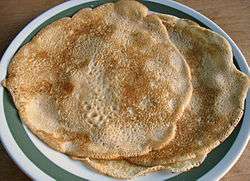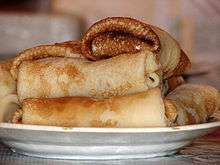Blini
 Blini | |
| Alternative names | Blin, bliny, blintchik |
|---|---|
| Type | Pancake |
| Place of origin | Russia |
| Main ingredients | Wheat, eggs, milk |
A blini (sometimes spelled bliny) (Russian: блины pl., diminutive: блинчики, blinchiki) or, sometimes, blin (more accurate as a single form of the noun), is a Russian pancake traditionally made from wheat or (more rarely) buckwheat flour and served with sour cream, quark, butter, caviar and other garnishes.[1] It's roots traces to ancient Slavic rituals.[2] They are also known as blintzes, crepes or palatschinke. Some English dictionaries record usage of the forms blin as singular and blini or bliny as plural, which correspond to the originally Russian forms, but some dictionaries consider this usage so rare in English that they do not mention blin at all and only record the widespread modern regular usage of blini for the singular and blinis for the plural, for example the American Heritage,[1] MacMillan,[3] and Vocabulary.com[4] dictionaries. Some cookbooks and restaurants use blin and blintchick as in Russian to refer to crêpes.
Blintzes are apparently an offshoot (an evolved or variant form) of blini. They are thin pancakes usually made of wheat flour (not buckwheat), folded to form a casing (as for cheese or fruit) and then sautéed or baked.[5] Blini are among the most popular and most-eaten dishes in Russia.
Etymology



Blini comes from the Russian word блины́ bliný (plural of блин blin), which refers to pancakes in general and comes from the Old Russian mlinŭ, blinŭ,[1] which comes from Old Slavic mlinъ,[6] (cf. млинець (mlynets’), Ukrainian for blin).
Use in modern Russian language
Blini are so deeply involved in Russian culture that the word Blin (блин) is used as a linguistic signal in communications. It is used when a person talks to others and is searching for the right words or if he expresses his dissatisfaction.
History
Blinis were considered by early East Slavic people in pre-Christian times to be a symbol of the sun, due to their round form.[7] They were traditionally prepared at the end of winter to honor the rebirth of the new sun (Butter Week, or Maslenitsa, also called "butter week" or "pancake week").[7] This tradition was adopted by the Orthodox church and is carried on to the present day. Drochena, a kind of blini, was also served at wakes to commemorate the recently deceased.
Traditional Russian blinis are made with yeasted batter, which is left to rise and then diluted with milk, soured milk, cold or boiling water. When diluted with boiling water, they are referred to as zavarniye bliny. A lighter and thinner form made from unyeasted batter (usually made of flour, eggs, milk or soured milk, kefir, ryazhenka, varenets), is also common in Russia. Traditionally, blinis are baked in a Russian oven. The process of preparing blinis is still referred to as baking in Russian, even though they are nowadays pan-fried, like pancakes. All kinds of flour may be used, from wheat and buckwheat to oatmeal and millet, although wheat is currently the most popular.
Blinis were popularized in the United States by Eastern European Jewish immigrants who used them in Jewish cuisine. While not part of any specific religious rite in Judaism, blinis stuffed with a cheese filling and then fried in oil are served on holidays such as Chanukah (as oil played a pivotal role in the miracle of the Chanukah story) and Shavuot (when dairy dishes are traditionally served within the Ashkenazi minhag). Blini and blinchiki are ordinarily stuffed before frying a second time, wrapped around stuffing and eaten without refrying or simply folded and eaten with a dip. Fillings include chocolate, mushrooms, meat, rice, mashed potatoes and cheese.
Varieties
Some ways that blinis are prepared and served include the following:
- Blinis made from batter containing various additions such as grated potato or apple and raisins.[7] Such blinis are quite common in Eastern Europe and Central Europe and are more solidly filled than the spongy pancakes usually eaten in North America.
- Blinis covered with butter, sour cream, jam, honey or caviar (whitefish, salmon or traditional sturgeon caviar).
They may be folded or rolled into a tube with sweet or salty fillings such as varenye, fruit, berry, mashed potatoes, quark, cooked ground meat, cooked chicken, salmon, chopped boiled eggs with green onions or chopped mushrooms.
- Blinis made with pouring batter over chopped vegetables, meat or mushrooms put on a frying pan beforehand are called "blini s pripyokom".
- Blintzes. A filling such as jam, fruit, potato, quark, cottage cheese or farmer cheese, cooked ground meat, cooked chicken and even chopped mushrooms, bean sprouts, cabbage and onions (for a Chinese eggroll-type blintz) is rolled or enveloped into a pre-fried blintz and then the blintz is lightly re-fried, sautéed or baked. Such blintzes are also called nalysnyky (Ukrainian: налисники) or krokiety (Polish). The caviar filling is popular during Russian-style cocktail parties.
- Buckwheat blinis are part of traditional Russian cuisine.[7] They are also widespread in Ukraine,[7] where they are sometimes known as hrechanyky (Ukrainian: гречаники), and Lithuania's Dzūkija region, the only region in the country where buckwheat is grown, where they are called grikių blynai.
Blinis are considered to be the traditional meal in Lithuanian culture on Shrove Tuesday.[8]
See also
References
- 1 2 3 "Photographic image" (JPG). Upload.wikimedia.org. Retrieved 2017-01-06.
- ↑ Biyuts, Lara. The Sunless Parlour. Lulu.com. ISBN 9781446192290.
- ↑ "blini definition and synonyms". Macmillan Dictionary. 2016-12-09. Retrieved 2017-01-06.
- ↑ "blini - Dictionary Definition". Vocabulary.com. Retrieved 2017-01-06.
- ↑ "blintze | a thin usually wheat-flour pancake folded to form a casing (as for cheese or fruit) and then sautéed or baked". Merriam-webster.com. Retrieved 2015-08-12.
- ↑ близорукий блинд. "блин - это... Что такое блин?". Dic.academic.ru. Retrieved 2017-01-06.
- 1 2 3 4 5 Marks, Gil (2010). Encyclopedia of Jewish Food. Wiley. pp. 56–58. Retrieved April 18, 2012. ISBN 9780470391303
- ↑ "Lithuanian Pancake Recipe - Blynai or Sklindziai". Easteuropeanfood.about.com. Retrieved 2015-08-12.
External links
- Kidd, Sue (March 21, 2012). "Blintzapalooza: It's more than just blintzes". The News Tribune. Tacoma, Washington. Retrieved April 18, 2012.
- Blintz recipe (with detailed photos) (in Russian)
- BBR OkiDoki. "BLIN: Soviet Russia". BattleBit Studios. Soviet Russia.